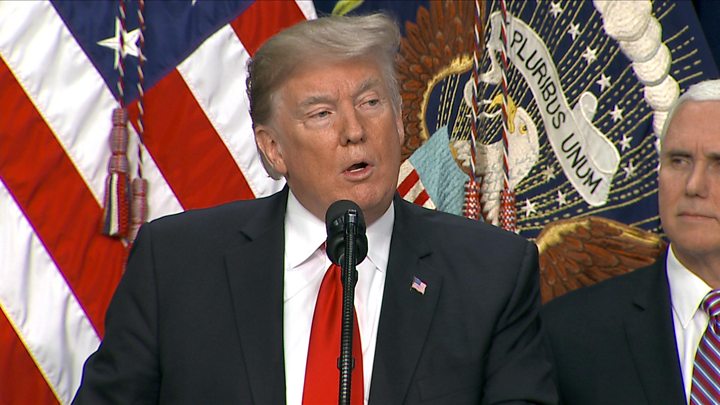 A partial US government shutdown has taken effect after US lawmakers failed to break a budget impasse.
A partial US government shutdown has taken effect after US lawmakers failed to break a budget impasse.
Mr Trump, who has to sign off any deal, is insisting at least $5bn (£4bn) in funding be included for his long-promised wall along the Mexican border.
Lawmakers adjourned last-minute talks on Friday evening.
In the absence of an agreement, funding for about a quarter of all US federal agencies lapsed at midnight (05:00 GMT Saturday).
It means the departments of Homeland Security, Transportation, Agriculture, State, and Justice will begin to shut down and federal national parks and forests will also be affected.
The partial closure, the third of 2018, means hundreds of thousands of federal employees will have to work unpaid or be put on temporary leave.
- Five big things from Trump’s head-spinning week
- Six surprising statistics about immigrants in the US
- US to investigate child migrant’s death
In a video address published on Mr Trump’s Twitter account shortly before the shutdown began, the president insisted the onus was on the Democrats to resolve the closure.
Senior Democrats have accused the president of provoking the situation with a “temper tantrum”.
What is the row about?
On Wednesday, a stopgap spending bill was passed in order to keep federal agencies open until 8 February – but the agreement did not include funding for Mr Trump’s wall.
After a rare backlash from his supporters and hard-line Republicans, Mr Trump dug his heels in over the issue and insisted funds for the wall must be included for him to sign it off.
Under current rules, spending bills are approved in the House of Representatives with a simple majority vote. Mr Trump’s party currently dominate that chamber, but the Democrats are set to take control of it in January.
The House has now approved $5.7bn (£4.5bn) of funding for the wall, but before the spending bill reaches the president it also needs to be passed by 60 votes in the Senate – where Republicans only hold 51 seats.
On Friday Mr Trump shared a graphic of his steel-slat wall design for the wall.
Later, he posted a video regarding the immigration row, where he said it was “very dangerous out there”.
His address, which was spliced with footage that appeared to show immigrants pushing down border fencing, cautioned about drugs and violent gang members entering the country illegally.
“We don’t want ’em in the United States, We don’t want ’em in our country,” Mr Trump said.
“The only thing that’s going to stop that is great border security with a wall, or a slat fence, or whatever you wanna call it.”
A strengthened southern border wall was a key election promise for Mr Trump.
During his campaign he insisted he would make Mexico pay for it, but the country has refused.
The Democrats have also remained resolute that US taxpayers should not pay for his plan.
This week Mr Trump’s supporters created a crowdfunding page for the building process – an appeal that has so far raised more than $13m (£10m) in just four days.
What will happen now?
After last-ditch talks failed to reach a resolution on Friday night, members of Congress left Capitol Hill but are expected to return on Saturday.
In his video, Mr Trump said “there is nothing” his Republican party can do about the shutdown and said “we need the Democrats to give us their votes” to resolve it.
“Call it a Democrat shutdown, call it whatever you want but we need their help to get this approved,” he said, before urging a bipartisan effort.
Speaking on the floor on Friday, Senate Democratic leader Chuck Schumer laid blame with the president.
“President Trump has thrown a temper tantrum and now has us careening towards a ‘Trump shutdown’ over Christmas,” Mr Schumer said.
Mr Trump has suggested Senate majority leader Mitch McConnell should invoke the so-called “nuclear option” to break the impasse.
The option would mean the bill could be approved in the Senate with a simple majority instead of the 60 currently required – bypassing the need for bipartisan support.
But Mr McConnell has repeatedly refused in the past to invoke such an extreme legislative manoeuvre.
A number of Republican senators on Friday also made clear their staunch opposition to the proposal.
The midnight closure is the third time US federal funding has lapsed so far this year.
What will the shutdown mean?
About 380,000 government employees will be made to take temporary, unpaid leave.
Meanwhile, 420,000 employees working in essential roles – considered necessary for the “protection of life and property” – will keep working, without being paid.
In practice, this means that:
- Customs and border staff will keep working, although their pay will be delayed. Airports will continue operating.
- About 80% of National Parks employees will be sent home, and parks could close – although some may stay open with limited staff and facilities.
- About 90% of housing department workers will take unpaid leave, which could delay loan processing and approvals.
- Most of the Internal Revenue Service will be sent on unpaid leave, including those who assist taxpayers with queries.
- The Food and Drug administration will pause routine inspections but “continue vital activities”.
- About 90% of the Nasa space agency’s staff could be sent home. However, Nasa says that in previous shutdowns it has kept enough personnel on to support the International Space Station as well as space missions that are in progress.
The remaining 75% of the federal government is fully funded until September 2019 – so the defence, veterans affairs, labour and education departments are not affected.
BBC
 Q FM Africa's Modern Radio
Q FM Africa's Modern Radio